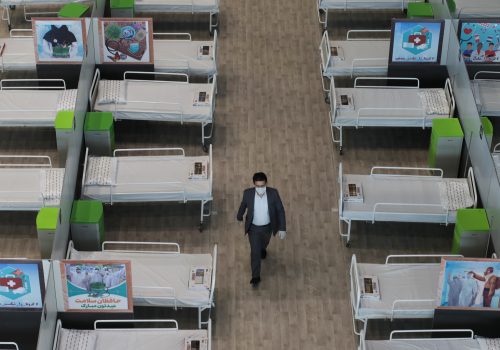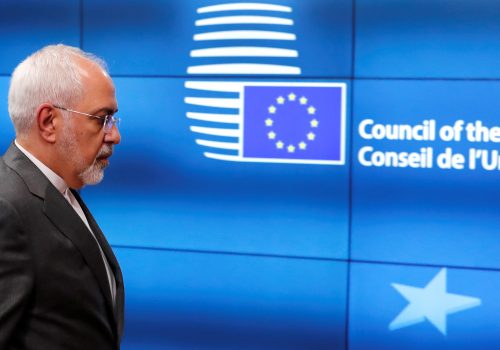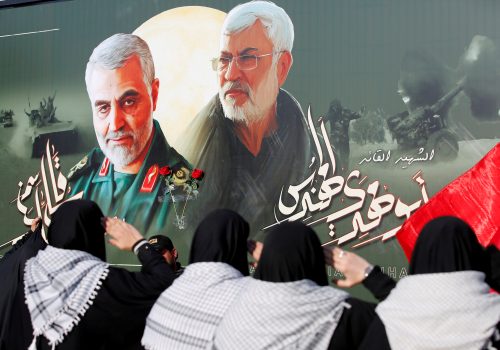Even a coronavirus pandemic can’t save religion in Iran
In January 1988, Supreme Leader Ayatollah Ruhollah Khomeini ruled, in a series of letters he exchanged with then-president Ali Khamenei and the Guardian Council, that the government has the authority to demolish a mosque or suspend the five pillars of Islam if state interests (masaleh-e keshvar) require it. Thirty-two years later and, though no mosque has yet been razed under that legal justification, the Islamic Republic was forced to close mosques, suspend Friday sermons, and prohibit pilgrimages and religious gatherings due to the outbreak of the coronavirus.
Religious ideological considerations have certainly influenced the Iranian authorities’ decision to avoid the closure of religious institutions. The clerical establishment opposed the recommendations provided by the Health Ministry to close religious centers in Qom and impose quarantine on the city—the focal point of Shia scholarship—which was also the epicenter of the pandemic in Iran. Mohammed Sa’idi, a Friday prayer leader and the representative of Supreme Leader Ali Khamenei in Qom, claimed on February 26 that there was no need to close the Fatemeh Masoumeh mosque after the outbreak of the disease, as it is considered to be a place of healing. “The dirty, villainous, and wicked Trump wants to strike a blow on Qom’s culture and reputation by using the excuse of coronavirus,” he said.
A few days later, however, Iranian authorities were forced to show flexibility, even in matters considered taboo, once the severity of the epidemic had become clearer. For the first time since the 1979 Islamic Revolution, the authorities canceled Friday prayers across Iran, eased the rules of Islamic burial ceremonies, and closed holy sites in Qom and Mashhad. They even allowed the reopening of an alcohol factory, which had been closed since the ban on alcohol consumption in 1979. Iran was prompted into this decision when several hundred people died after drinking methanol in attempt to cure themselves of the coronavirus.
The controversial decision to shut down the religious centers was made despite furious reactions from some hardliners who considered it an insult to Islam. Following the closure of the shrines of Fatemeh Masoumeh in Qom and Imam Reza in Mashhad, several dozen believers tried to break into the closed mosques and managed to confront the security forces.
The authorities have also taken harsh measures against proponents of Islamic “folk medicine” and superstitions. For example, authorities arrested two worshippers and charged them with conducting superstitious acts after they licked holy shrines in Qom and Mashhad to prove that holy sites were immune to the virus. In another case, authorities summoned an Islamic medicine cleric, who was seen—in videos circulated on social media—asking patients to smell the perfume he had rubbed on them to heal them of COVID-19. Another man, claiming to be a specialist in Islamic medicine, was detained by the Tehran police in late April for insulting Islam and disturbing public order after calling on Iranians on social media to drink camel urine to ensure they had the “best cure” for the coronavirus infection. The surge in bogus prescriptions for a cure prompted a warning from Health Minister Saeed Namaki, who claimed that some “illiterate charlatans and demagogues” were trying to deceive people under the guise of Islamic and traditional medicine.
This is not the first time the Islamic Republic has opposed a person or group that it regards as a threat to its monopoly on religion. The Iranian regime, for example, has repressed the Nematollahi Gonabadi order—Iran’s largest Sufi order—which believes that religion and politics should be kept separate. In an effort to maintain its clerical monopoly on Islam and status as “official” interpreter, the regime has also attempted to limit expressions of popular Islam and superstition. Ayatollah Safi Golpaygani stated, in 2006, that superstitions should be confronted because there are forces interested in promoting these beliefs to undermine the basis of faith and foundation of reason.
At the same time, however, senior Iranian officials, including Supreme Leader Khamenei, continued to propagate conspiracy theories and superstitions. In his speech on the occasion of Nowruz, the Iranian New Year, he referred to two groups of enemies: humans and the army of Jinn; the latter being invisible supernatural creatures with extraordinary powers of destruction that work hand-in-hand with other enemies.
It is still too early to assess what impact the coronavirus might have on the importance of religion and faith in Iran. A recent poll conducted by the Iranian Students Polling Agency (ISPA) found that 47 percent of the respondents reported that the importance of God and religion has increased following the outbreak, while 48.4 percent said it has remained the same. The remaining 3.5 percent responded that the place of God and religion in their life has diminished. This may not come as a surprise, as many Iranians turn to religion in desperate times and consider it a source of protection against disease. It also provides a sense of collective identity which is especially crucial in times of crisis.
While faith might play a much broader role during such tumultuous times, the position of the clerical establishment is likely to deteriorate even further. In recent decades, Iranian society has experienced growing secularization accompanied by increasing alienation between the public and the clerics. The excessive politicization of religion in Iran, the regime’s failure to resolve the growing economic and social hardships, and widespread corruption have all diminished the appeal of religion.
Statements by Iranian clerics reflect their mounting concern with the ongoing erosion of their public status. In an interview conducted in September 2018, Hojjat-ul-Islam Nasser Naqavian warned that clerics were gradually losing their standing. He claimed that Iranian clerics had once provided support for citizens, who relied on them, trusted them, and consulted with them regarding even the most sensitive personal issues. However, clerics’ involvement in political affairs have been detrimental to their reputation and many citizens, today, are unwilling to even greet them in the street.
An editorial written by Mehrab Sadeqnia, a lecturer at the religious seminary of Qom, also addressed the growing public animosity toward the clerics. Sadeqnia wrote that he typically refrains from appearing publicly in traditional clerical garb in order to avoid the hostile responses from people on the street. He reported that when he, once, used the Tehran Metro dressed as a cleric, he encountered antagonism from civilians, who gave him hostile looks and, in some cases, addressed him with derogatory comments.
Another indication of the eroding position of the clerical establishment can be seen in the increasing public influence of the Iranian eulogists (maddahan), in recent years. The maddahan are more closely identified with the general public, are more aware of its concerns and hardships, and are also considered to be more adept at mobilizing the general public because of their rhetorical skills. Reza Taran, a theology student at a religious seminary in Qom, has attributed the rising popularity of the maddahan to the growing divide between Iran’s religious establishment and the country’s citizens. In the past, clerics maintained good relations with the citizens on a regular basis and the public looked upon them as a major source of authority and supported them financially. Today, most clerics content themselves with a weekly Friday sermon in a mosque and avoid almost all contact with the public, which has an adverse impact on their public position. Under these circumstances, the eulogists are replacing the clerics’ role as representatives of the public.
In the short run, the coronavirus may reinforce religious belief among ordinary Iranians. With that in mind, Iranian authorities are likely to continue their efforts to maintain a positive image of Islam consistent with reason and science. It is, nevertheless, highly doubtful that those attempts will be able to improve the image of Iranian clerics who have been in power over the past four decades. Forty-one years after the Islamic Revolution, the public’s confidence in the religious establishment, which is perceived by many Iranians as responsible for their hardships, has eroded. While the clerics still enjoy significant political influence, their social position appears to be in decline.
Dr. Raz Zimmt is a research fellow at the Institute for National Security Studies (INSS) specializing in Iran and a veteran Iran-watcher in the Israeli Defense Forces.
Image: Members of the medical team spray disinfectant to sanitize outdoor place of Imam Reza's holy shrine, following the coronavirus outbreak, in Mashhad, Iran February 27, 2020. Picture taken February 27, 2020. WANA (West Asia News Agency) via REUTERS ATTENTION EDITORS - THIS PICTURE WAS PROVIDED BY A THIRD PARTY


